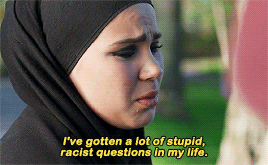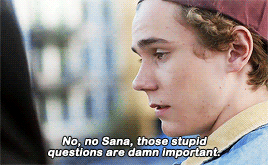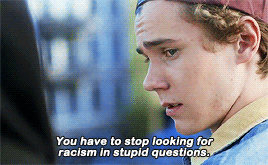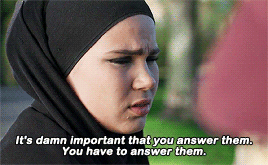Skam
“Season 3’s coming-out storyline is fascinating to watch because it breaks from using the traditional coming-out tropes.”
Title: Skam (“Shame”)
Episodes Reviewed: Seasons 1-4
Creator/Director/Writer: Julie Andem 👩🏼🇳🇴
Reviewed by Mimi 👩🏻🇺🇸
Technical: 4/5
Not since the beloved UK series Skins have I been so addicted to a contemporary teen drama. Similar to Skins, the Norwegian series Skam purports to offer a realistic portrayal of teenagers as they actually are, and not how network execs imagine them to be. It taps into the Internet generation, rolling out short clips throughout the week as if the story is unfolding in real time before packaging them together into one episode at the end of the week. Other tidbits appear on social media, allowing fans to feel even more connected to the characters and the unfolding drama. And thanks to readily available fansubs on the Internet, Skam has become something of a cult favorite in the U.S.
The show boasts a deliberately “unpolished” look: shaky, handheld shots mimic the feel of an amateur video uploaded to YouTube, although the outdoor scenes are always beautifully framed. Likewise, the makeup and styling are on point; they never tried to cover up an actor’s blemished skin because, even though the CW would have you believe otherwise, real-life teenagers do get pimples. And the sometimes awkward or stilted dialogue reminds us of just how painfully inarticulate we all were at that age.
Gender: 4.25/5
Does it pass the Bechdel Test? YES
Each season of Skam focuses on a different character, and the real joy of Season 1 was its establishment of the female friendships that would become the bedrock of the show. At the outset, Eva (Lisa Teige) appears to have no female friends, choosing instead to funnel all of her time and energy into her relationship with boyfriend Jonas (Marlon Langeland). Later, we learn that a past falling out with a former best friend is the reason for Eva’s isolation. Now, having to start anew upon entering high school, she nervously waits for a friend request approval from a new classmate, Noora (Josefine Frida Pettersen), endearingly acting as one would for a crush. The two soon join forces with three other misfits—Vilde (Ulrikke Falch), Chris (Ina Svenningdal), and Sana (Iman Meskini)—for reasons having to do with a Norwegian coming-of-age tradition known as russ, which you’ll just have to read about on your own in order to understand. While many of the group’s antics revolve around Vilde’s scheming and chasing after a clique of popular senior boys, the collective failure to raise their social standing eventually forces the young women to confront such evils as bullying, gossip-mongering, and slut-shaming. The evolution, from petty disagreements through unshakable solidarity, showcases the sometimes needless yet forever inescapable complexities of adolescent girls and their friendships. As a grown, 30-something woman watching this show, I found it simultaneously unbearable to relive and 100% accurate.
Sadly, Season 2 (by far the weakest of the four) becomes weighed down by Noora’s unhealthy relationship with a controlling and manipulative guy. The show makes a decent attempt at addressing a plot point involving sexual assault. But, honestly, I worried about the lesson girls would take away from Noora’s character arc. Ultimately, Noora’s savior isn’t a man but her friends, and that’s the saving grace for the audience, as well.
Race: 3.75/5
Given that Norway is not only overwhelmingly white but also ethnically homogenous (other ethnic groups make up just 2% of the population according to a 2007 estimate), and only 2.3% of Norwegians identify as Muslim (2011 estimate), Season 4’s centering of a character that’s both the daughter of immigrants and devoutly Muslim feels incredibly progressive. Unlike other popular depictions of first-generation and immigrant Muslims who aren’t explicitly religious (Abed in Community, Dev in Master of None, and most recently Kumail Nanjiani in The Big Sick), Sana’s beliefs, and her struggle to practice her faith while still just trying to live a regular (by Western standards, that is) teenage life, are thoroughly explored. Although we’ve seen hijabi women on television before, the choice to never show Sana without a headscarf on feels both respectful and truthful to her character.
The crux of Sana’s personality seems to be that she comes off as a badass (her lipstick game alone is to die for), which only serves to hide her inner vulnerability. She later attributes this outer toughness to being bullied in middle school, and we see her defense mechanisms in full force when she finds herself at odds with her female classmates. I applaud the show’s effort to create a dialogue about intersectionality: a scene between Sana and a gay, white character Isak (Tarjei Sandvik Moe) comes oh-so close to being a real reckoning about what it’s like to grow up as a minority in a majority white country. They just miss sticking the landing by basically putting the impetus on Sana to have to teach others about Islamophobia and racism.
It was also somewhat uncomfortable to watch all the girls in her class, including Sana’s friends, who are all white, turn on her, only to be told that it had nothing to do with race. I think this is where, in spite of Norway’s social progressivism, its homogeneity as a society reveals its immaturity on racial issues. Personally, I would have watched an entire series about Sana and her brother’s friends (those cute Balloon Squad boys), and genuinely wish someone would just write that. Outside of Sana’s season, however, much of the show features montages of well-off white kids partying and listening to rap music.
LGBTQ: 3.5/5
Season 3’s coming-out storyline is fascinating to watch because it breaks from using the traditional coming-out tropes. While Isak does have to deal with conservative parents, his classmates, and even his straight male friends, are largely tolerant (bless Generation Z). The conflict is mostly internal. Naturally, there’s plenty of angst when it comes to the romance that’s the catalyst for Isak’s self-revelation. There is a poignant conversation between the then-closeted Isak and his more out-and-proud roommate Eskild about the privileges of being straight-passing, with a reminder not to forget those who paved the way and who fought for the rights they enjoy now. But for the most part, the show largely sidesteps making any pointed political commentary, or exploring other facets of what it means to be a queer youth.
Bonus for Disability: +0.50
Without spoiling too much, I’ll just add that Season 3 generates some thoughtful discussion about mental health—in particular, de-stigmatizing the issue for those who may not initially know how to approach it.
Mediaversity Grade: B 4.00/5
Like many of Skam’s fans worldwide who took to social media to mourn the finale, I agree it seems a shame that creator Julie Andem decided to end the series when she did. It felt like the show was hitting its stride with the two latter seasons and I would have been interested to see how it might have gone on to tackle other characters such as Vilde (whose mother suffers from depression), or Chris (who was sort of pigeonholed as the “big” girl), or Mahdi (played by Sacha Kleber Nyiligira, who was the lone black actor among the boys). Also, I thought the whole premise of the girl squad becoming friends was so that they could obtain a russ bus for graduation, and now I guess I’ll never get to find out what the heck russ is.





